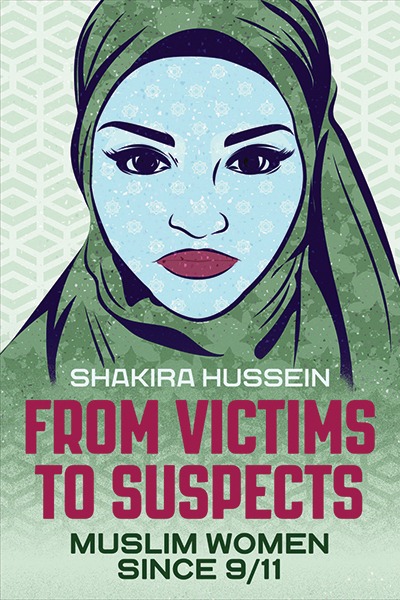
Once regarded as passive victims waiting to be rescued, Muslim women are now widely regarded as arbiters of “terror” and a potential threat to be kept under control. In her book “From Victims to Suspects: Muslim Women Since 9/11” (Yale University Press). Shakira Hussein, a research fellow at the University of Melbourne’s Asia Institute, draws on interviews and examples from around the world to show how this shift in attitude has taken place and how it impacts feminism, multiculturalism, race, and religion.
Why did you decide to write this book, and why now?
From Victim to Suspects had a very long germination process. It’s based on research that I undertook throughout the post 9/11 era in locations ranging from Australia to Pakistan to Europe and the United States. Like many other Muslim writers and scholars, I hoped that this type of work might help to prevent Samuel Huntington’s dystopian “clash of civilisations” from becoming a self-fulfilling prophesy. And writing a steady stream of media articles as well as my PhD thesis provided much-needed stress relief during turbulent political times.
However, I gradually found myself overwhelmed by pain, fatigue and problems with physical coordination. Initially, I was prepared to believe that these symptoms were caused by “too much thinking about this whole 9/11 business”, but I was eventually diagnosed with multiple sclerosis (although I think that 9/11-itis also played a role). I’d like to be able to claim that I had the foresight to time the publication of the book to coincide with the controversy over the fate of the women and girls seeking to return to their home countries after the collapse of the so-called Islamic State in Syria and Iraq. However, the advent of new and much more effective treatments for multiple sclerosis had a lot more to do with my ability to finally consolidate my research into a full-length book. Having said that, the issues that I discuss in the book are coming to a head right now, so I’m glad that it’s been released at this particular moment.
You explore the centrality of gender to the US case for the Afghan war. Could you expand?
The transnational feminist campaign against the Taliban had been underway for some time prior to 11 September 2001, attracting support from celebrities such as talk show host Oprah Winfrey and Vagina Monologues playwright Eve Ensler. After the attacks on New York and Washington, this campaign became a central to the overall casus belli, regardless of the fact that the warlords of the Northern Alliance were guilty of similar abuses. The need to protect Afghan women has been an ongoing theme whenever political and public support for the war seemed the be faltering, as revealed by a 2010 leaked US military memo which recommended that testimonials from Afghan women be used to counter negative European sentiment towards the NATO mission. The current peace-process is still regularly described as a betrayal of Afghan women, despite the United Nations having stated that more Afghan civilians are now being killed by the Afghan government and the United States military than by the Taliban and other insurgents.
Could you explain the history of this kind of imperial feminism?
Gayantari Spivak summarised this history with her much-cited line about “white men rescuing brown women from brown men”. The white men concerned often had very little time for women’s rights in their own country, with the British Consul-General of Egypt, Lord Cromer, condemning Islam for its oppression of women, while also serving as the president of the Men’s League for Opposing Woman’s Suffrage back home. We see Cromer’s successor in US Secretary of State Mike Pompeo, who has spoken out very strongly in support of women’s rights in Iran, while seeking to control women’s reproductive rights throughout the world by banning US aid to services that promote or provide abortions. Of course, very few liberal feminists support those particular measures, but white women continue to play an important role in imperial rescue missions, which can provide them with purpose and status within the patriarchal structures of their own societies.
In rejecting such heavy-handed imperialism, is there a risk of justifying or overlooking practices that actually are oppressive to women?
The research that I undertook with the women’s wing of the Islamist Jamaat-i-Islami in Pakistan brought home that risk to me, particularly in the wake of the attack on Malala Yousafzai by the Pakistani Taliban. One of my JI interviewees (herself a highly-educated woman and former member of the National Assembly) tweeted a photograph of Malala and her father in a meeting with the US Special Representative to Afghanistan and Pakistan Richard Holbrooke, implying that the young activist was nothing more than an American stooge. But many of the critiques of Malala from left-wing anti-war activists were not much more sophisticated than that. I was infuriated by the way that such activists would denounce the way that the attack on Malala was being used to justify US drone attacks in the region, without recognising that these criticisms were feeding into the anti-Malala conspiracy theories that were rampant within Pakistan and Pakistani communities worldwide. Of course we ought to recognise the many other casualities of the war on terror besides Malala, who herself has spoken out against drone attacks. But far too much energy has been invested in lazy critiques of Malala Yousafzai as a supposed pawn of US imperialism rather than on amplifying the stories of those other victims.
Why and how have Muslim women shifted from being seen primarily as victims to being suspects?
The most high-profile female Muslim suspects are the women and girls who have provided support to organisations like al-Qaeda, Boko Haram, and ISIS. However, Muslims living in the West are increasingly regarded as a cultural as well as a security hazard, seen as a threat to the host society’s way of life because of the shifts that we bring about by our mere presence. Women are a key reproducers of culture and community in both the metaphorical and the literal sense. Mainstream politicians as well as far-right extremists have described Muslims as posing an existential demographic threat, with the culprit in the Christchurch terrorist attack citing “the birthrates” as his justification for killing women and children along with their menfolk. Apparently, wombs can be as dangerous as bombs.
You write about the “moral panic” triggered by gender segregated events in the UK and Australia. Why do you think this causes such anxiety?
Single sex schools, women’s only gyms, and gender-segregated sporting clubs and venues are far from unusual in most Western societies, even as gender diversity has become more visible. And yet Islamic student societies are represented as the enemy within because their social events feature gender-segregated seating arrangements. On one level, this double-standard is just a straightforward example of racist scapegoating. However, I think it also illustrates a deeper insecurity about shifts in what had been regarded as stable identities and boundaries. It’s easier to admonish Muslims for allegedly failing to uphold “our” values than it is to resolve internal culture wars over issues (or non-issues) like allowing transwomen access to designated female space.
You dedicate a chapter to “jihadi brides”. What is your view on the media/political discussion about these young women?
Sex and death have always been a very compelling combination in the media and entertainment industries, and coverage of the so-called jihadi brides has certainly played into that. The willingness of young British, European and Australian-born women to aid, abet and of course have sex with men who commit misogynist crimes is regarded as an abhorrent betrayal of their gender, as well as the values of the societies in which they were raised. The relish at seeing these very young women – some of them still legally children – get what many regard as their just desserts is a disturbing form of misogyny. On the other hand, I question whether defending them as the victims of grooming is a useful approach. The appeal of the Islamic State for young people was that it told them that they were adults who didn’t need to obey their elders. Describing them as misguided children doesn’t show sufficient respect for their agency.
What would a better feminist discussion of Muslim women and the issues impacting them look like?
Well, for a start it would shift away from the obsession with “the veil”, whether in the form of headscarves or face-veils. Of course, this is an important topic for many women themselves, but regardless of our personal opinions and choice of dress, most of us are fed up with always being asked to talk about the veil while issues like national security, immigration, religious and racial discrimination are regarded as best left to the men.
And it would also acknowledge the role that white feminism has played (and continues to play) in the oppression of racialised minorities, including Muslims. Decolonisation is a central project for many women as well as men in those communities. Feminism won’t gain much traction unless it’s prepared to contribute to that – or at the very least, not stand in its way.
How can these sweeping stereotypes – oppressed victim, dangerous suspect – be countered? You discuss how “positive” portrayals of Muslim women can also be problematic.
Media outlets often cite these types of reports as evidence of their balanced approach to discussion of “the Muslim issue”. For example, scare-stories about sinister women in burqas are “balanced” by stories celebrating hijab-wearing women as pathbreakers – the first hijab-clad newsreader, or sportsperson, or police officer – even the first hijab-wearing woman to pose for Playboy magazine. These women are always described as standing outside the norms of their religious community, even when they describe that community as a source of support. Muslim women who raise their voices against gender violence and religious extremism find can themselves in an even more fraught situation, conscripted sometimes without their knowledge or consent as useful vehicles for government propaganda campaigns. We ought not to have to justify our civil rights in terms of our value as consumers, brand ambassadors, and national security assets.

